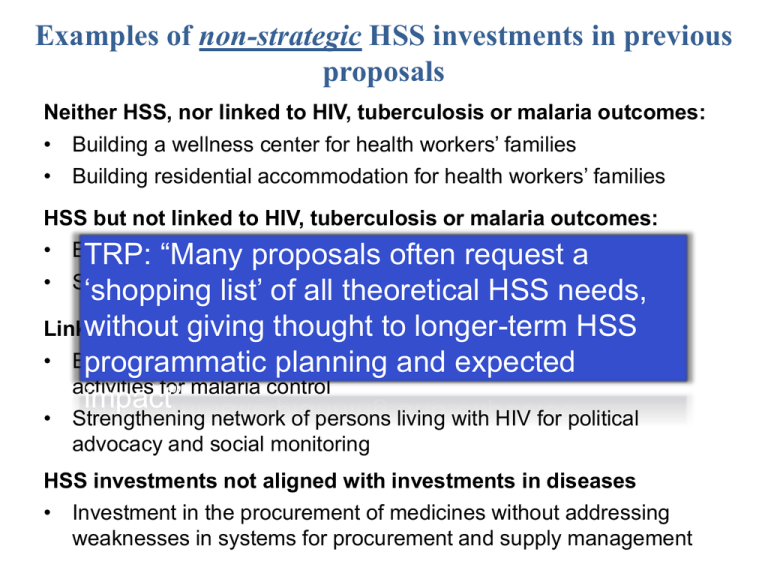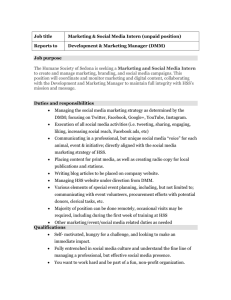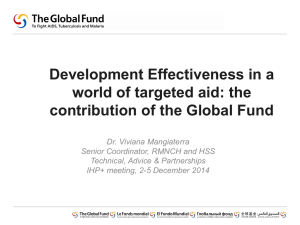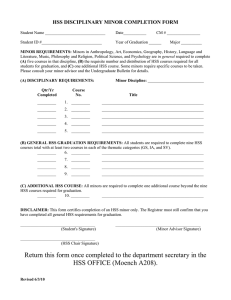non-strategic proposals
advertisement

Examples of non-strategic HSS investments in previous proposals Neither HSS, nor linked to HIV, tuberculosis or malaria outcomes: • Building a wellness center for health workers’ families • Building residential accommodation for health workers’ families HSS but not linked to HIV, tuberculosis or malaria outcomes: • Building nursing school to scale-up nurses for psychiatric TRP: a“Many proposals often request a care • Supporting stipends for academic degree training (MPH) ‘shopping list’ of all theoretical HSS needs, Linked to HIV, giving tuberculosis or malaria outcomes, but HSS not HSS: without thought to longer-term • Employing communityplanning organizations to carry out communication programmatic and expected activities for malaria control impact” • Strengthening network of persons living with HIV for political advocacy and social monitoring HSS investments not aligned with investments in diseases • Investment in the procurement of medicines without addressing weaknesses in systems for procurement and supply management NFM offers the Opportunity to Improve Quality of HSS Investments • Guidance on HSS investments and tools o Programmatic risk analysis across HIV, TB, malaria portfolio identified most frequent system-related risks in: PSM, HRH, HMIS, service delivery, financial management, and these have been prioritized for HSS investments o “Limited flexibility” is allowed for interventions beyond these areas, if a certain set of criteria are met o Strategic allocation of scarce resources: focus on most-in-need countries for HSS investments (differentiated allocation/scope by country Bands) o HSS concept note template, instructions, modular tool • Structured mechanism for TA provision at the proposal and implementation stages • Country dialogue and iterative process – Secretariat provides input to proposal development before approval • Measurement and evidence generation o Integration of the HSS component in national disease program reviews • Institutional capacity o HSS/RMNCH team, cross-divisional WG, CT training Illustrative Examples of Potential Demand for HSS Investments in 2014: Geographic, thematic and grant architecture diversity Afghanistan: Stand-alone cross-cutting HSS (community health workforce, HMIS, integrated laboratory services) Nigeria: Cross-cutting HSS included in HIV application (PSM, HRH, HMIS) Pakistan: Cross-cutting HSS included in TB application (PSM, HMIS) South Sudan: Stand-alone cross-cutting HSS grant Ukraine: Cross-cutting HSS included in joint TB-HIV application (healthcare financing, service delivery reform) Zambia: Cross-cutting HSS included in joint TB-HIV application (HRH, service delivery at the community level, PSM) 3 Options for HSS Funding Request Options No request for crosscutting HSS - “diseasespecific” HSS embedded in disease grants, but not labeled as HSS. Include cross-cutting HSS in disease requests Develop an HSS concept note for a stand-alone HSS grant Develop TB/HIV concept note Align multiple diseasespecific concept notes When to consider Some countries may 41 countries with2high choose to prepare or 3 TB/HIV co-infection eligible disease concept All countries are eligible burden are expected to notes simultaneously. Cross-cutting HSS tocountries apply for are a concept standsubmit a single These Sufficient resources are needs and aThey financing alone cross-cutting note for TB/HIV. strongly encouraged to HSS available for crossgap areencouraged identified, but except upperaregrant strongly consider cross-cutting cutting HSS needs to country does not wish to middle income countries to consider cross-cutting HSS needs. ensure prepare concept note without higha successful disease HSS needs of HIV, forimplementation a stand-alone HSS burden tuberculosis and malaria grant programs New Partnership Mechanisms to Maximize Impact of NFM Partnership agreement with WHO on providing technical assistance in HIV, TB, malaria and HSS for funding request development. (Signed May, 2014) MoU with UNICEF on providing non-HIV/TB/malaria commodities (e.g. antibiotics, zinc, ORS…) for ICCM and other RMNCH interventions to broaden impact of GFATM investments. (Signed, May 2014) MoU with UNFPA to support countries secure additional resources for HSS, particularly in the areas of HRH, PSM and in the provision of integrated, quality and equitable sexual and reproductive health services (in progress) To support national strategies that address the delivery of an integrated and equitable package of sexual and reproductive health services; To advance the integration of sexual and reproductive health services in programmatic planning, budgeting, implementation and evaluation. In some cases UNFPA may be in a position to meet relevant programmatic costs as part of its existing country program action plans. 5



